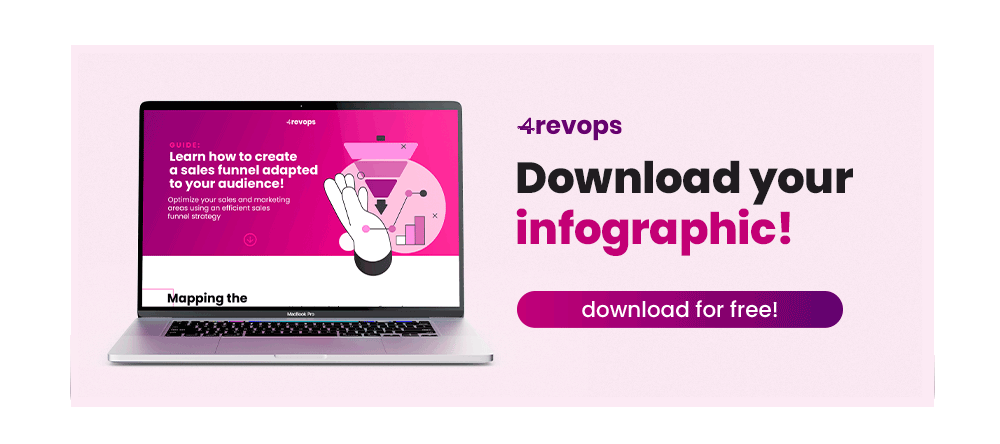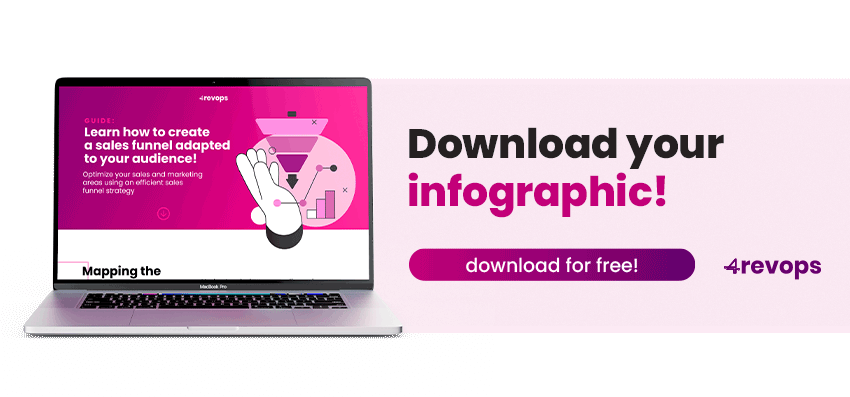The sales funnel is a strategy addressed mainly by the areas of sales and marketing, but it offers benefits to all sectors of the organization. However, this result will only be achieved if the structuring of thisfunnel is efficient and targeted to the right audience.
In this post, we will explain in more detail what is the sales funnel, in addition to explaining step by step how to develop this strategy thinking about your audience and get the best results in attracting customers.
- What is a sales funnel?
- How to make a sales funnel targeted to your audience?
- Map the audience journey
- Define the steps for each stage of the funnel
- Establish the actions of the sales and marketing teams
- Identify the key characteristics of a qualified lead
- Implement lead scoring
- Constantly Optimize Your Funnel
Want to check it all out? Then read on!
What is a sales funnel?
A sales funnel is a strategy that aims to map the journey of a client from his first contact with the business until the moment he purchases your product or service.
This strategy is divided into several steps, which are known as steps of the sales funnel. Each of them requires a different approach on the part of the company, so that the user can go through all of them, and in the end, become a customer.
To make the process easier and richer in data, institutions use CRMs to monitor this strategy. Now, you might be wondering: what is CRM and what is it for?
The CRM is a software that helps the teams of attendance, Sales and Marketing. Through it, it is possible to collect some simple data from users, such as their phone number, name and email.
That way, the service team will be able to reach that person more easily, or it will allow the marketing team to make a more targeted strategy.
How to make a sales funnel targeted to your audience?
Now, it's time to understand what are the steps that are part of this process so that you can create an effective strategy for your audience.
- Map the audience's journey;
- Define the steps for each stage of the funnel;
- Establish the actions of the sales and marketing teams;
- Identify the main characteristics of a qualified lead;
- Implement lead scoring;
- Optimize your funnel constantly.
Continue reading to learn more about each of these steps!
Map the audience journey
The first step to creating a sales funnel is precisely to seek to understand who your audience is and how he is interacting with your company. There are two ways to do this, one aimed at existing customers and the other at organizations just starting out.
A public mapping strategy for institutions that already have clients is mainly based on the creation of a persona, which is a semi-fictional character created from information collected by the company from its current clients.
As for organizations that still do not have a significant number of customers, the main strategy is to try to talk to people who have already purchased their product or service and understand what were the motivations for them to become involved.become your customers.
It is important to keep in mind that this journey mapping may undergo changes over time, as your own product or service may change, or the interests of those you want to reach may have changed according to different factors.
Define the steps for each stage of the funnel
After knowing your audience well, it's time to define each of the stages of your sales funil. This is a very necessary moment that directs the marketing management and customer relationship.
You can start this process by defining the main steps, which are attraction, consideration, and decision. However, it is interesting that you go beyond them and also create steps that are specific to the particularities of your audience.
This is also the ideal time for you to define the milestones of these users, that is, the actions taken by them that show the achievement of a certain maturity and, thus, they can move on to the next stage of their sales funnel.
The definition of milestones will be of great help to direct the action of your team of marketing and sales (something we'll talk about in the next topic). They Will get identify the triggers that indicate the need to convince this user to move to the next step quickly and efficiently.
Establish the actions of the sales and marketing teams
Despite the sales funnel needing the collaboration of the entire institution, the sales and marketing areas are the ones that are most commonly engaged in this strategy. Therefore, it is important to define the actions of each one of them, as well as how they can help in this process.
For example: if your sales team needs to hit a target of X sales per month, you should expect the marketing team to be able to bring in as many qualified leads as possible for this target to be met.
We call this partnership of marketing and sales teams “vendarketing”. Betting on this strategy is very efficient, as it aligns the customer relationship from these two areas.
In practice, the marketing team will be able to work better with your leads to deliver to the sales team and at the same time sales professionals will be able to do their part considering the work already done by the marketing team.
Identify the key characteristics of a qualified lead
We talked a lot in the previous topic about lead, which is precisely the central point of our next step to create a sales funnel targeted to your audience: define and identify a lead as qualified.
There is no general situation that identifies when the user becomes a qualified lead, this is something that needs to be defined in a personalized way by each institution, after all, only they will know the characteristics of a person who is highly inclined to do business with them.
One way to identify the qualified lead is to assess whether it fits into certain scenarios. For example: a qualified lead has an “identification” with the product or service you offer, that is, he is aligned with your segment and has the power of decision and purchase.
It is also necessary to analyze whether the lead is showing signs that he is interested in buying. Many may be engaged on their social media, but that doesn't mean they really want to complete an order. Search for more direct actions, such as placing a product in the cart.
Read too:
- Marketing 5.0: get closer to your potential customers;
- The 6 best tips on how to make a communication ruler!;
- What is a communication guideline and how does it work? Check out.
Implement lead scoring
Have you heard about lead scoring? Through it, you can create a score for your leads. With each action he performs with your brand, such as downloading an e-book or visiting your website, he earns a certain amount of points.
In this way, leads that manage to reach a certain goal of points can be classified as a qualified lead, advancing in the sales funnel or be passed on to the sales team, which may initiate an approach aimed at transforming you into a customer.
One of the main benefits of adopting lead scoring is that it allows your marketing and sales teams to work more efficiently. This happens because the analysis of these is much easier, and can even become automated
In addition, the sales team will always receive the most qualified leads, since they already have a long relationship with the brand and have shown themselves, through actions, to be more inclined to close a deal.
Constantly Optimize Your Funnel
Following all these steps, you can already create a sales funnel very efficient and directed to the particularities of its own public. However, don't think that the work is over here.
It is very important that you always analyze each of the stages of your funnel and the strategies that are being made based on it. This way, you can more easily identify problems related to them and think of ways to optimize your results.
Besides the sales funnel, it is also necessary to always keep an eye on your audience, as they may undergo changes over time and this may also require adjustments in your marketing strategy.sales funnel.
As a result, your metrics will also improve, as well as the relationship you cultivate with your future client. Your communication and adopted strategies will be more assertive, which will ensure frequent and high frequency conversions.
In short: to create a sales funnel suitable for your audience, you need to map the audience's journey, define the steps of each stage of the funnel, establish the teams' actions, identify the main characteristics of a qualified lead, implement the lead score and constantly optimize your funnel.
In this way, learning how to create a sales funnel targeted to your audience, you will achieve significant gains in lead qualification and, consequently, increase your sales.
To help you fix this content or facilitate future consultations, we have prepared an infographic with the main information of this blogpost. Download it right now, it's free!

































